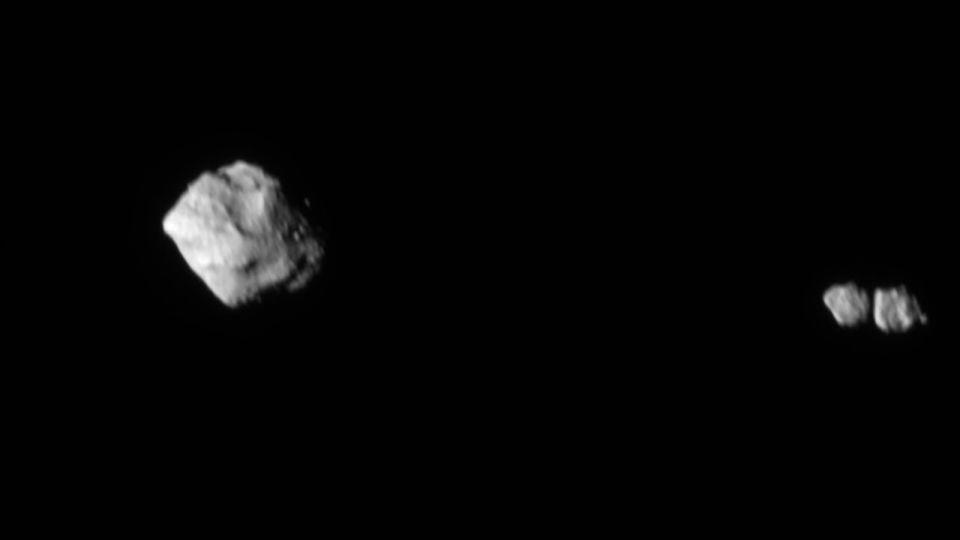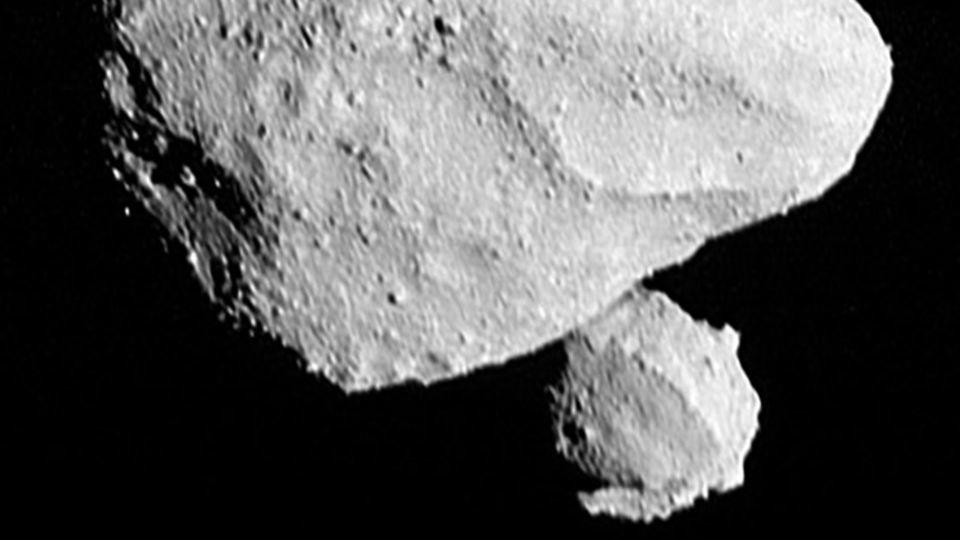Sign up for CNN’s Wonder Theory science newsletter. Explore the universe with news about fascinating discoveries, scientific advancements and more.
Astronomers got a surprise when NASA’s Lucy mission flew past an asteroid called Dinkinesh in November and detected a contact binary (two small space rocks touching each other) orbiting the asteroid like a moon.
This was the first time a contact binary was discovered orbiting an asteroid.
Now researchers have had the chance to examine Lucy’s observations, and the findings, published Wednesday in the journal Nature, reveal that “Dinky” and its contact duo, now called Selam, are more complex than expected.
The complexity of both space rocks could change the way astronomers understand how asteroids and even planets like Earth formed in the early days of our solar system.
“We want to understand the power of small objects in our solar system because that’s critical to understanding how planets like Earth got here,” study lead author Hal Levison, Lucy’s principal investigator at the Southwest Research Institute in Boulder, Colorado, said in a statement. .
“Basically, planets formed when millions of small objects, such as asteroids orbiting the Sun, collided with each other. “How objects behave when they collide with each other, whether they break apart or stick together, has a lot to do with their strength and internal structure.”
Dinkinesh is in the main asteroid belt located between Mars and Jupiter.
In addition to Selam’s discovery, Lucy’s observations showed a ridge and a trough in Dinkinesh. At some point in Dinkinesh’s history, a quarter of the asteroid suddenly slipped and broke off.

“The pit is suggestive of a sudden failure rather than a slow process like dune formation, more of an earthquake with a gradual build-up of stress followed by a sudden release,” said study co-author Keith Noll, a Lucy project scientist at NASA’s Goddard Space Flight Center. said. at a statement in Greenbelt, Maryland.
The pit and Dinkinesh’s earthquake-like response are helping scientists better understand the asteroid’s internal structure.
Dinkinesh’s difficult history
Since Dinkinesh is not a perfect sphere, the asteroid receives uneven amounts of sunlight from different directions.
“Solar radiation puts pressure on it, and over time the asteroid begins to spin, and once it gets fast enough, material is shed,” said study co-author Jessica Sunshine, a professor of astronomy and geology at the University of Maryland, College Park. .


Dinkinesh’s warming and faster rotation likely occurred over millions of years, and centrifugal forces in the space rock caused part of the asteroid to bend into an elongated shape and shed debris. The debris then entered a close orbit around Dinkinesh, with some of the material falling onto the asteroid and forming a ridge, while the remaining material likely formed Selam.
If Dinkinesh were made of weaker, sandier material, the asteroid’s particles would drift toward the space rock’s equator and be released into space as it spins faster. But Lucy’s images show Dinkinesh’s rocky body holding together much longer and more strongly, eventually breaking into large pieces.
“These features tell us that Dinkinesh has some power and allow us to do a small reconstruction of the history to see how this asteroid evolved,” Levison said. “It ruptured, pieces separated from each other, and during this failure a disk of material was formed, some of which rained back onto the surface to form the ridge.”
But Selam and the process behind its formation still puzzle astronomers. Sunshine said no current theory can explain how two nearly equal-sized pieces flew out of Dinkinesh and eventually came together as a contact binary. But he said figuring out how Selam was formed was “part of the fun.”
Sunshine was also part of NASA’s Double Asteroid Redirection Test research team. The September 2022 mission, also known as DART, deliberately sent a spacecraft hurtling into a moonlet called Dimorphos and orbiting a larger, near-Earth asteroid called Didymos to alter the motion of a celestial object in space.
“I am personally very excited to compare the Didymos binary system with (Dinkinesh), especially since they appear to have many similarities such as size, general shape, and possibly composition, despite being in completely different parts of the solar system,” he said. “They have very different characteristics, but we think they may have gone through similar processes to become what we know today.”
The NASA Galileo mission photographed asteroid 243 Ida and its moon on August 28, 1993, detecting the first asteroid known to have a lunar moon.
Since then, scientists have discovered more asteroids with moons called binaries.
“15% of the near-Earth asteroid population now has binaries,” Sunshine said.
Uncovering the secrets of asteroids
Lucy’s flyby near Dinkinesh was part of testing on the spacecraft’s equipment ahead of the mission’s primary objective: the investigation of the Trojan asteroid swarms around Jupiter. Dinkinesh’s flight, which means “wonderful” in Ethiopia’s Amharic language, wasn’t even added to Lucy’s itinerary until January 2023.
Lucy’s next close encounter, scheduled for 2025, will be with another main belt asteroid called Donaldjohanson. The spacecraft will then set out to see the Trojans.
Trojan asteroids, named after Greek mythology, revolve around the sun in two swarms; one is in front of Jupiter, the largest planet in our solar system, and the other is behind it. Asteroids too distant to be seen in detail with telescopes will be seen up close when Lucy reaches the Trojans in 2027.
The mission takes its name from the Lucy fossil, the remains of an ancient human ancestor discovered in Ethiopia in 1974. The skeleton has helped researchers piece together various aspects of human evolution, and NASA Lucy team members hope their mission will achieve similar success. The history of our solar system.
Selam takes its name from the 3.3 million-year-old fossil of a little girl, thought to be a child-like fossil of Lucy. Selam means “peace” in Ethiopian Amharic.
Asteroids are like fossils; It represents materials that were left hanging around after the formation of the giant planets in our solar system, including Jupiter, Saturn, Uranus, and Neptune.
“Our ultimate goal is to understand the formation of celestial bodies,” Sunshine said. “How are planets formed? How was the world formed? We know that large planets are formed from smaller objects, so studying these small asteroids allows us to see how materials behave and interact on a smaller scale. “Together with Dinky and the other asteroids we pass by, we are laying the foundation for understanding how planets form.”
For more CNN news and newsletters, create an account at CNN.com